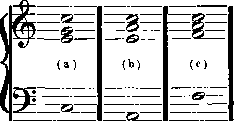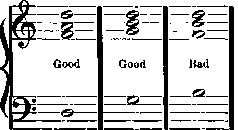Harmony Book For Beginners - online book
Scales, Intervals, Common Chords, Dominant Seventh Chord and Melody Making.
| Share page | Visit Us On FB |
|
HARMONIZING A MELODY - |
||||
|
CHAPTER XI
HARMONIZING A MELODY
The knowledge gained in the preceding chapter may be applied to the harmonization of a Melody, or upper voice part. To a given bass part we have been adding three other parts or voices. If we examine the various exercises we will find that each note of the topmost part or voice in each exercise is either the Root, the Third or the Fifth of a Chord. This gives the clue to our reasoning.
In harmonizing a Melody we must decide each note as we come to it: whether it
is to be the Root, the Third, or the Fifth of a Chord. The Melody Note for instance, might belong to either of the three following chords:
 |
||||
 |
||||
|
At (a), it is the Root of the Chord C-E-G; at (b), the Third of the Chord A-C-E; at (c), the Fifth of the Chord F-A-C. Play each of these many times and compare the effects. Learn to recognize each one when heard. |
||||
|
|
||||
|
Let us take |
 |
, the Second Degree in the Scale of C. It might be the |
||
|
|
||||
|
Root of the Chord D-F-A, or the Fifth of the Chord G-B-D, but it should not be used as the Third of the Imperfect Chord B-D-F. |
||||
|
|
||||
 |
||||
|
The remaining Degrees in the Scale of C may be harmonized in a similar mannei as follows:
E F G A B |
||||
|
|
||||
 |
||||